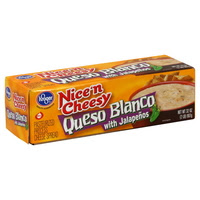Some people on our “Foods of the Lower East Side” tours are familiar with queso blanco and queso fresco. Others are a bit confused: we’re talking about things that translate to “white cheese” and “fresh cheese,” and they are both fresh white cheeses. One distinction between the two is that most of the cheeses referred to as queso blanco do not melt when heated but rather soften and hold their shape, making them ideal for fried cheese or bits of hot cheese in things, while queso fresco is more likely to be eaten with fruit or crumbled, cold.
 |
| Homemade Queso Fresco with Chiles |
As my colleague Renzo Ortega has said, very firmly, it is not a good idea to put all Spanish-speaking peoples into “the same box” just because they speak Spanish—or to over-generalize about their foods. So it’s important to remember that queso blanco and queso fresco are loose categories that refer to different varieties of cheese in different regions.
Of course, fresh white cheeses aren’t proprietary to Spanish-speaking nations. They’re traditionally made in regions that form a belt around Earth’s equator—historically, where it’s too hot to age cheese. In this category are the aforementioned quesos; also Indian panir, Syrian halloumi (a white goat and sheep milk cheese that can be grilled), Italian mozzarella and ricotta, quark, fromage blanc, a variety of fresh goat and sheep cheeses, kefir cheese, and many others.
 |
| Grilled Corn with Queso Blanco |
Spanish-speaking people who came to the U.S. and the Lower East Side were accustomed to having cheap, fresh, white cheeses, but could not easily bring these cheeses with them. Fresh cheeses, especially those traditionally made of raw milk, are not cheap (or necessarily legal) to import: An imported raw milk cheese must be aged for at least 60 days. Having noted that the white cheeses of Batista in the Essex Street Market are all American-made, I googled “imported Dominican cheese” and found numerous articles about smuggling and mass outbreaks of tuberculosis and listeriosis.
So immigrants used what was available--Monterey jack is a common stand-in. But the availability of more authentic cheeses is changing. Currently, the push for more authentic quesos comes both from consumers—not all of them immigrants or children of immigrants—who want access to these cheeses and from companies that would like to sell more of them.
Tom Shore, a Pine Hill, North Carolina, Anglo dairy farmer, learned from Hispanic neighbors to make queso blanco when he could no longer support his farm selling his milk. In the early 2000s, some of his neighbors were buying raw milk (illegal in North Carolina) and making their own cheeses, rather than pay $8/lb for the imported (pasteurized) stuff. Outbreaks of listeriosis resulted in miscarriages. When this story was originally reported in 2004, there were more than 350,000 Latinos, mostly Mexican, in North Carolina, but no reliable access to their fresh cheeses. By the time a business site called “Hispanic Trending” picked up this story, they called it “Queso Cash-Cow”. It ain’t subtle, but is indeed relevant to the story of how the foods of immigrants do or do not become available in the U.S.
 |
| Maria Castro, Founder of Castro Cheese, in the mid-1960's |
Other companies making or distributing American-made quesos began with Latino immigrants. The Castro Cheese Company of Houston, which sells “La Vaquita” products, was begun in 1971 by Mexican immigrant Maria Castro. She said their customers “find the flavors, the tastes, the smells, the memories that take us back to our roots. Back to our mother’s kitchens. That’s why they love ‘La Vaquita’". At the end of 2010, Castro sold the business to a national consortium. It was a family company, but you can’t make enough cheese in mama’s kitchen to supply Wal-Mart.
One of the biggest of the “Hispanic” cheese producers in the U.S., Tropical Cheese Industries of New Jersey, was also started by an immigrant, Rafael Mendez from Cuba, in the early 1960s. He began by making feta cheese with some Greek immigrants and then expanded into Caribbean, Mexican, and Central American varieties as demand increased.
My inclination (as a middle-class foodie) is to be sarcastic about the mass-market brands that replace regionally specific originals. Kroger’s Supermarket sells store-brand “Nice’n Cheesy Queso Blanco with Jalapenos,” for instance. Yet these are likely to be the cheeses that are readily available and affordable to people who are not middle-class foodies.
 |
| Kroger's Queso Blanco |
As we look at how immigrants adopt “American” cheeses, it’s also interesting to note that many recipes for “American” foods now call for previously unavailable Latin American cheeses. For example, a recent press release for El Mexicano brand Queso Fresco Casero suggested it “as an alternative for feta, mozzarella, or Monterey Jack” and for use in “all kinds of soups, salads, and casseroles.” On a more daring note, Tropical Cheese Industries offers recipes for “Tropical Cheese Asian Noodle Salad” and “Chocolate and Queso Blanco Fondue”.
Fusion, here we come….
--Posted by Tenement Museum Educator Judy Levin

No comments:
Post a Comment
Note: Only a member of this blog may post a comment.